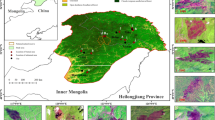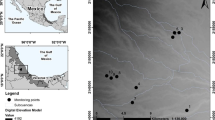Abstract
Temperate humid grazing lands are an important component of the landscape of the northeastern United States, as well as of the economy of this region. Unlike their European counterparts, little is known about the basic ecology of managed grasslands in this region. During an 8-year survey of 28 farms across the northeastern United States, we sampled the vegetation on 95 grazed plots, identifying 310 plant species, and collected data on topography, climate and soils. Landscape structure data were obtained from the National Land Cover Data (NLCD) 2001 for six radii (250–2,000 m) surrounding each site. The 500-m radius was most strongly related to plant community composition. Planned species composition was related only to site factors, while associated species were influenced by both site factors and landscape pattern. Species richness was unrelated to landscape structure for either group. Differing management effects on planned and associated species may explain the variation in their responses. Managed grasslands are a critical part of the interconnected landscape of the northeastern United States, and both affect and are affected by their surroundings.



Similar content being viewed by others
References
Anderson J, Hardy E, Roach J, Witmer R (1976) A land use and land cover classification system for use with remote sensor data. U.S. Geological Survey Professional Paper 28. USGS, Washington, DC
Baker WL, Cai Y (1992) The r.le programs for multiscale analysis of landscape structure using the GRASS geographical information system. Landscape Ecol 7:291–302
Borcard D, Legendre P, Drapeau P (1992) Partialling out the spatial component of ecological variation. Ecology 73:1045–1055
Bruun HH (2000) Patterns of species richness in dry grassland patches in an agricultural landscape. Ecography 23:641–650
Bruun H (2001) Determinants of species richness in patches of grassland and heathland in Himmerland (Denmark). Nordic J Bot 21:607–614
Cornell Cooperative Extension (2005) Grassland birds regional pasture use inventory. Cornell Cooperative Extension Publication, Schuyler County, NY
Cousins S, Ohlson H, Eriksson O (2007) Effects of historical and present fragmentation on plant species diversity in semi-natural grasslands in Swedish rural landscapes. Landscape Ecol 22:723–730
Dauber J, Hirsch M, Simmering D, Waldhardt R, Otte A, Wolters V (2003) Landscape structure as an indicator of biodiversity: matrix effects on species richness. Agric Ecosyst Environ 98:321–329
Eriksson A, Eriksson O, Berglund H (1995) Species abundance patterns of plants in Swedish semi-natural pastures. Ecography 18:310–317
Goslee S, Urban D (2007) The ecodist package for dissimilarity-based analysis of ecological data. J Stat Softw 22(7):1–19
GRASS Development Team (2008) Geographic Resources Analysis Support System (GRASS) Software. Open Source Geospatial Foundation Project. Available from http://grass.osgeo.org. Accessed December 2008
Homer C, Dewitz J, Fry J, Coan M, Hossain N, Larson C, Herold N, McKerrow A, VanDriel JN, Wickham J (2007) Completion of the 2001 National Land Cover Database for the conterminous United States. Photogram Eng Remote Sens 73:337–341
Klimek S, Kemmermann A, Hofmann M, Isselstein J (2007) Plant species richness and composition in managed grasslands: the relative importance of field management and environmental factors. Biol Conserv 134:559–570
Krauss J, Klein A, Steffan-Dewenter I, Tscharntke T (2004) Effects of habitat area, isolation, and landscape diversity on plant species richness of calcareous grasslands. Biodivers Conserv 13:1427–1439
Kumar S, Stohlgren TJ, Chong GW (2006) Spatial heterogeneity influences native and nonnative plant species. Ecology 87:3186–3199
Legendre P, Legendre L (1998) Numerical ecology. Elsevier, Amsterdam
Lobel S, Dengler J, Hobohm C (2006) Species richness of vascular plants, bryophytes and lichens in dry grasslands: the effects of environment, landscape structure and competition. Folia Geobot 41:377–393
Mantel N (1967) The detection of disease clustering and a generalized regression approach. Cancer Res 27:209–220
Marini L, Scotton M, Klimek S, Pecile A (2008) Patterns of plant species richness in Alpine hay meadows: local vs. landscape controls. Basic Appl Ecol 9:365–372
Mazerolle M, Villard M (1999) Patch characteristics and landscape context as predictors of species presence and abundance: a review. Ecoscience 6:117–124
McGarigal K, Cushman SA, Neel MC, Ene E (2002) FRAGSTATS: spatial pattern analysis program for categorical maps. University of Massachusetts Amherst. Available from http://www.umass.edu/landeco/research/fragstats/fragstats.html. Accessed August 2007
Moser D, Zechmeister H, Plutzar C (2002) Landscape patch shape complexity as an effective measure for plant species richness in rural landscapes. Landscape Ecol 17:657–669
Oksanen J, Kindt R, Legendre P, O’Hara B, Simpson GL, Solymos P, Stevens MHH, Wagner H (2010) Vegan: Community Ecology Package. R package version 1.17-0. Available from http://vegan.r-forge.r-project.org/. Accessed January 2010
R Development Core Team (2009) R: a language and environment for statistical computing, Version 2.10.1. Vienna, Austria. Available from http://www.R-project.org. Accessed January 2010
Riitters K, O’Neill R, Hunsaker C, Wickham J, Yankee D, Timmins S, Jones K, Jackson B (1995) A factor analysis of landscape pattern and structure metrics. Landscape Ecol 10:23–39
Simmering D, Waldhardt R, Otte A (2006) Quantifying determinants contributing to plant species richness in mosaic landscapes: a single- and multi-patch perspective. Landscape Ecol 21:1233–1251
Sims JT, Wolf A (1995) Recommended soil testing procedures for the northeastern United States. Northeast Regional Bulletin #493. Agricultural Experiment Station, University of Delaware, Newark, DE
Soderstrom B, Svensson B, Vessby K, Glimskar A (2001) Plants, insects and birds in semi-natural pastures in relation to local habitat and landscape factors. Biodivers Conserv 10:1839–1863
Spatial Climate Analysis Service (2006) 1971–2000 climate normals: annual minimum and maximum temperature and total annual precipitation. Oregon State University, Corvallis, OR. Available from http://www.ocs.oregonstate.edu/prism. Accessed July 2006
Stohlgren T, Falkner M, Schell L (1995) A modified-Whittaker nested vegetation sampling method. Vegetatio 117:113–121
Swift M, Izac AN, van Noordwijk M (2004) Biodiversity and ecosystem services in agricultural landscapes- are we asking the right questions? Agric Ecosyst Environ 104:113–134
Tscharntke T, Klein AM, Kruess A, Steffan-Dewenter I, Thies C (2005) Landscape perspectives on agricultural intensification and biodiversity: ecosystem service management. Ecol Lett 8:857–874
USDA (2005) Plants Database. Available from http://plants.usda.gov. Accessed November 2005
USDA-ERS (2009) Census of agriculture state fact sheets. Available from http://www.ers.usda.gov/StateFacts. Accessed December 2009
Weibull A, Ostman O, Granqvist A (2003) Species richness in agroecosystems: the effect of landscape, habitat, and farm management. Biodivers Conserv 12:1335–1355
Wickham JD, Stehman SV, Fry JA, Smith JH, Homer CG (2010) Thematic accuracy of the NLCD 2001 land cover for the conterminous United States. Remote Sens Environ 114:1286–1296
Zeleny D, Li C-F, Chytry M (2010) Pattern of local plant species richness along a gradient of landscape topographical heterogeneity: result of spatial mass effect or environmental shift? Ecography (in press)
Acknowledgments
B. F. Tracy was responsible for establishing this project and much of the early data collection. J. M. Gonet participated in vegetation sampling and geographic data analysis. This work contributes to the Conservation Effects Assessment Project (CEAP), jointly funded, coordinated and administered by the United States Department of Agriculture’s Natural Resources Conservation Service, Agricultural Research Service, and Cooperative State Research, Education, and Extension Service.
Author information
Authors and Affiliations
Corresponding author
Rights and permissions
About this article
Cite this article
Goslee, S.C., Sanderson, M.A. Landscape context and plant community composition in grazed agricultural systems of the Northeastern United States. Landscape Ecol 25, 1029–1039 (2010). https://doi.org/10.1007/s10980-010-9477-y
Received:
Accepted:
Published:
Issue Date:
DOI: https://doi.org/10.1007/s10980-010-9477-y




